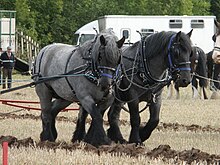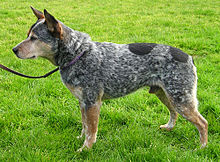Roan (color)
Roan is a coat color found in many animals, including horses, cattle, antelope, cats and dogs.
It is defined generally as an even mixture of white and pigmented hairs that do not "gray out" or fade as the animal ages.
"[3] Gray horses, which become lighter as they age until their hair coat is nearly completely white, may be confused with roans when they are young.
Horses with the classic or true roan pattern may be any base color which is intermingled with unpigmented white hairs on the body.
Except for white markings under the control of other genes, the head, mane, tail, and lower legs are dark.
[3] The mutation responsible for true roan has not yet been identified exactly, but been assigned to equine chromosome 21 (ECA21) in the KIT sequence.
[2] Sometimes called ticking, rabicano is common even in breeds that do not have true or classic roan, including Arabians and Thoroughbreds.
Instead, dogs with roaning or ticking are born with clear, open white markings which begin to fill in with flecking in the subsequent weeks and continue to darken with age.
In breeds that are characterized by roaning and ticking such as the Large Munsterlander, clear white-marked individuals may be called plated.
[14] Roan in Shorthorns and Belgian Blues is controlled by the mast cell growth factor (MGF) gene, also called the steel locus, on bovine chromosome 5.
It is worth noting that, unlike anophthalmic hamsters, guinea pigs with the condition are not sterile, but females may be unable to deliver live young.






